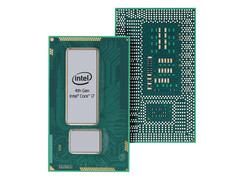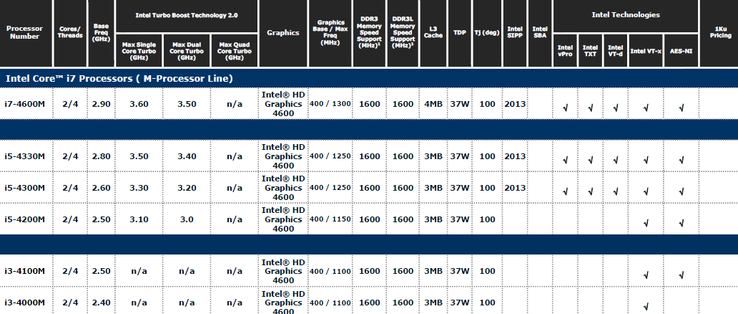Shortly after unveiling their new quad-core Haswell processors earlier this week - details found here in our review - Intel has taken the wraps off their cheaper dual-core processors. Similar to the Ivy Bridge generation, the CPUs are available in three categories, the M-series for notebooks, the U-series for slimmer Ultrabooks and the Y-series for tablets.
Are you a techie who knows how to write? Then join our Team! Wanted:
- News Writer
Details here
M-Series:
Upon looking at the details of the M-series, one can't help but feel a little disappointed. No increase in clock speed is seen when compared to the previous generation, with some models even experiencing a dip in base and maximum turbo frequencies. For example, the Core i7-4600M now runs only from 2.9 to 3.6 GHz, unlike the older i7-3540M which ran from 3.0 to 3.7 GHz.
The same principle applies to the Core i3 and i5 Haswell versions, which only experience moderate gains, despite the 10% per MHz performance increase that is expected. In addition, the TDP increases from 35 to 37 watts, although that is due to integration of the voltage converter into the CPU rather than higher consumption.
The M-series also won't be outfitted with the more powerful GT3/GTe graphics, and makes do with the GT2, Intel Graphics HD 4600. The 4600 does offer up to 30% more power than the previous HD 4000 line, but it is still easily beaten by even a GeForce GT 720M.
U-Series:
Where the M-series disappointed the U-series shines, especially with the top-of-the-line Core i7-4650U. Designed to enable thinner and more powerful Ultrabooks, the U-series main focus is in reducing energy demand. As a result, the TDP has been lowered from 17 to 15 watts and S0ix support is included, further reducing consumption when idle.
The CPU performance is around the same as the previous generation due to lowered base and turbo speeds, but the graphics definitely take a giant leap forward. Most of the Core i5 and i7 models will now be powered by Intel HD Graphics 5000, which offers 24 more Execution Units (EUs) than the 16 EUs found on the HD 4000 graphics. The rest of the series, including the entire Core i3 lineup, are outfitted with the slower HD Graphics 4400, which only features 20 EUs.
Y-Series:
First introduced with the Ivy Bridge generation, the Y-series is aimed for slim tablets with limited cooling capabilities that would be overwhelmed by the "normal" heat waste of ULV processors. Again, Intel was able to reduce the existing platform TDP from 16 watts to only 11.5 watts, while the SDP (typical consumption under certain conditions) reaches 6 watts.
Unfortunately, the reduced consumption doesn't come cheap and the two featured chips, the Core i5-4200Y and the Core i3-4010Y, are now overclocked to several hundred MHz slower than the previous models. Consequently, overall performance won't be much different, even with the improved HD Graphics 4400 and 4200.
Based on previous experience, it won't be too long until the aforementioned models find their way into actual devices. In addition, we expect many more options in the coming weeks and months, as Intel wants to bring around 60 new mobile 4th generation processors to the market this year. Most of those will be part of the U(LV)-class, including those of the unannounced 28-watt family featuring Iris Graphics 5100.
For more information about the individual models, be sure to check out our detailed info in the CPU database:
M-Series:
U-Series:
- Core i7-4650U
- Core i7-4550U
- Core i7-4500U
- Core i5-4350U
- Core i5-4250U
- Core i5-4200U
- Core i3-4100U
- Core i3-4010U
Y-Series:


 Deutsch
Deutsch English
English Español
Español Français
Français Italiano
Italiano Nederlands
Nederlands Polski
Polski Português
Português Русский
Русский Türkçe
Türkçe Svenska
Svenska Chinese
Chinese Magyar
Magyar


